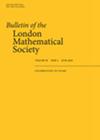关于2-配合物的普遍配对
IF 0.9
3区 数学
Q2 MATHEMATICS
引用次数: 0
摘要
在Freedman, Kitaev, Nayak, Slingerland, Walker和Wang, J. Geom中定义了流形的普遍配对,并证明了它在4维上缺乏正性。[j].植物学报,2005,23(3):393 - 397。我们证明了2-配合物的类似结果,并证明了普适配对不能检测到简单同伦等价与3-变形的区别。对于2-配合物,这两种等价关系是否不同的问题是Andrews-Curtis猜想的主题。我们还讨论了高维配合物的普遍配对,并证明了它是不正的。本文章由计算机程序翻译,如有差异,请以英文原文为准。



On the universal pairing for 2-complexes
The universal pairing for manifolds was defined and shown to lack positivity in dimension 4 in [Freedman, Kitaev, Nayak, Slingerland, Walker, and Wang, J. Geom. Topol. 9 (2005), 2303–2317]. We prove an analogous result for 2-complexes, and show that the universal pairing does not detect the difference between simple homotopy equivalence and 3-deformations. The question of whether these two equivalence relations are different for 2-complexes is the subject of the Andrews–Curtis conjecture. We also discuss the universal pairing for higher dimensional complexes and show that it is not positive.
求助全文
通过发布文献求助,成功后即可免费获取论文全文。
去求助
来源期刊
CiteScore
1.90
自引率
0.00%
发文量
198
审稿时长
4-8 weeks
期刊介绍:
Published by Oxford University Press prior to January 2017: http://blms.oxfordjournals.org/

 求助内容:
求助内容: 应助结果提醒方式:
应助结果提醒方式:


